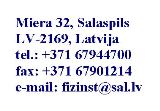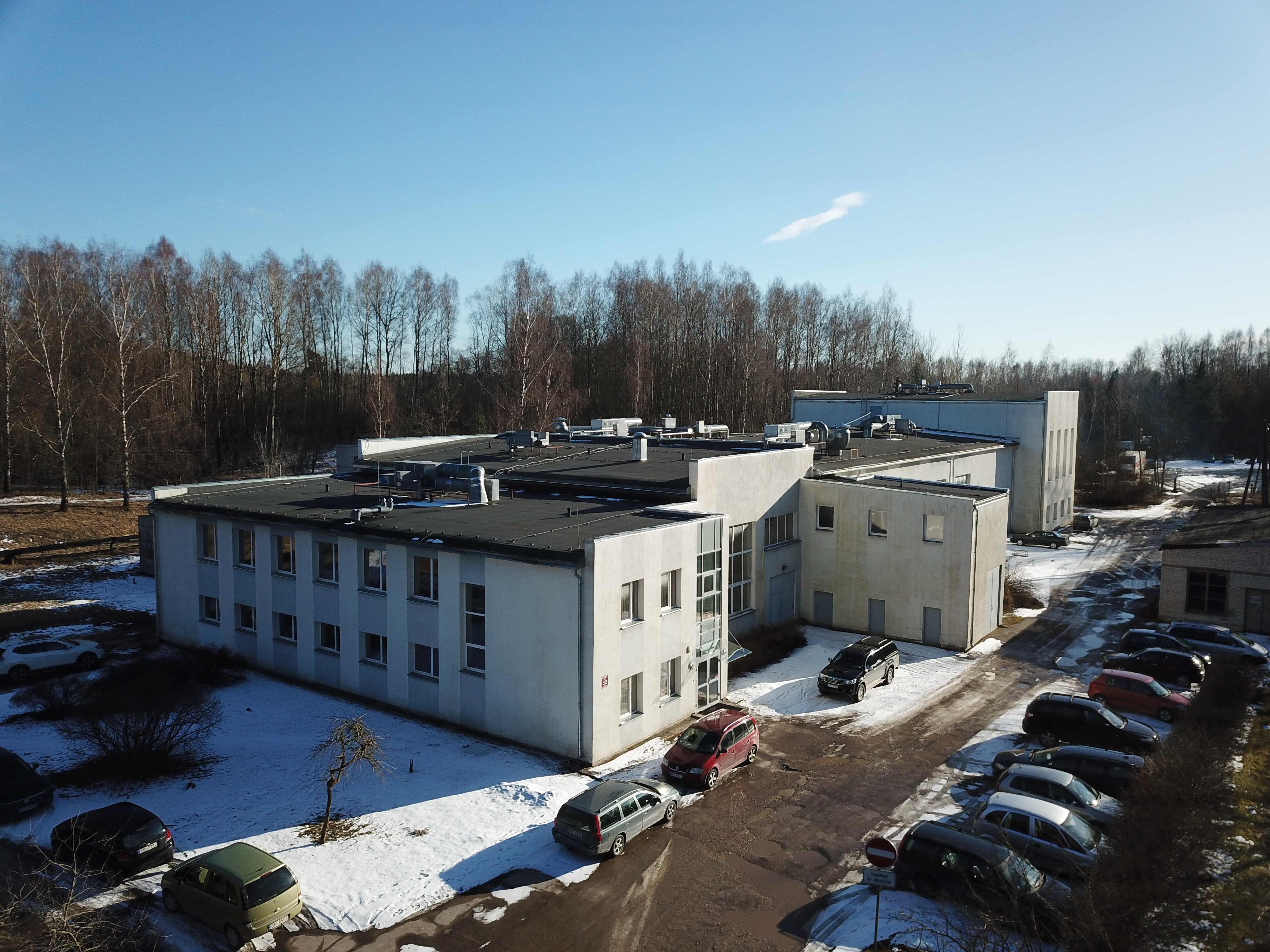The Institute of Physics of
University of Latvia (previously - Institute of Physics of
Latvian Academy of Sciences) is recognized as one of the oldest and
largest worldwide centres in the field of fundamental and applied
magnetohydrodynamics (MHD) research. The employees of the Institute of
Physics (about 75 employees) carry out complex investigations of the
electrodynamic, hydrodynamic and heat/mass transfer phenomena occurring
in liquid conducting media subject to the influence of electromagnetic
fields of different types, in particular, with respect to the problems
of engineering physics and liquid metal technologies. Numerous versions
of electromagnetic pumps and other specific devices for alloys
transport, stirring, pouring, conditioning have been developed for
ferrous and non-ferrous metallurgy, for the technologies of composite
material production and growth of semiconductor single crystals and so
on. The wide experience of the Institute of Physics in the field of
work with liquid metal media, the appropriate experimental equipment
and developed specific methods and procedures of measurements in molten
metals and alloys allow to perform physical and numerical simulations
of different technological processes in order to work out new original
MHD methods for controlling the hydrodynamic and heat/mass transfer
characteristics of melts in metallurgy and single crystal growth from
the melt.
Crystal growth and metallurgy
related research is concentrated in the
Laboratory of MHD technology of
IPUL.
Current activities of this
laboratory are focused on complex fundamental and applied research
dealt with investigations of physical laws of a new scientific trend in
applied magnetohydrodynamics – “The use of combined electromagnetic
fields for controlling the transfer process in solidifying melts”. This
trend has been set forth in the Institute of Physics of the University
of Latvia. The scientific value of this field of research is determined
by a wider use of electromagnetic methods to influence crystallization
phenomena in molten metals, alloys and semiconductor materials. Already
now the electromagnetic methods of treatment are used in a number of
various technologies related with production of specific alloys and
high-quality single crystals. The main objectives of the current
research are: 1) To investigate optimal versions of a complex influence
on the hydrodynamics and heat/mass transfer in the melt, which solidify
under the impact of different combinations and superposition of
alternating and steady magnetic fields; 2) To find out the principles
of solidifying media behavior under the changed by different types of
MHD influence conditions of heat/mass transfer in the melt and at the
interface; 3) To study the relationship of hydrodynamic and
crystallization phenomena influenced by electromagnetic forces in
different methods used at the production of semiconductor single
crystals and special alloys; 4) To work out scientific and technical
grounds for new MHD methods of transfer process control in solidifying
media at production of single and polycrystalline materials.
Institute of Physics is also one of the pioneers in the
magnetic fluid
research. Starting the early 1970-ies in Institute have been
performed
vide spectrum of basic and applied research: static and dynamic
magnetization of subdomain particles in ferrocolloids,
ferrohydrodynamics including the colloid magnetoviscosity and
magnetorheology, thermomagnetic and magnetic solutal convection, heat
and mass transfer including the high gradient magnetic separation of
nanoparticles in ferrocolloids and that of cells in biological
suspensions, magnetic fluid technology. The Institute is relatively
well equipped for performing physical experiments as well as for
preparation of ferrofluid samples for basic and applied research.
Besides the main interest to basic phenomena, a great attention is paid
also to some applied problems, firstly, to the loudspeaker cooling and
to the magnetic cell separation and magnetic drug targeting. At the
present the research is concentrated in two departments: in the
Department of Theoretic
Physics and
in the
Laboratory of Heat and Mass
Transfer.
Current activities of the
Laboratory
of Heat
and Mass Transfer are
directed to the development of new temperature-sensitive ferrofluids
for potential application in sensors as well in thermal engineering
(firstly, the magnetically controlled thermosiphons and the
thermomagnetic cooling of high power electric transformers). Besides
the pyromagnetic properties of complex ferrite nanoparticles in
dispersions, a great attention is paid to the transport properties of
colloidal particles in non-isothermic colloids under the effect of a
magnetic field and of strong temperature gradients. Currently, an
intensive thermodiffusive transfer of nanoparticles in hydrocarbon and
water based colloids is established. The basic research on Soret effect
in ferrofluids is performed by organizing a close collaboration with
partners in Germany (Prof. S. Odenbach, Center of Applied Microgravity,
University of Bremen) and in France (Prof. A. Bourdon and Prof. R.
Perzinsky, Pierre and Marie Curie University Paris-VI). It is planed to
establish new collaborative contacts with some teams dealing with
thermodiffusion problems in ordinary macromolecular liquids (Prof. S.
Wiegand, Max Plank Institute of Polymer Research, Germany Dr. A.
Shapiro, Technical University of Denmark, Denmark).
Activities of the research group of Prof. A. Cebers, who is leading
researcher at IPUL and professor of theoretical physics at the faculty
of mathematics and physics of University of Latvia, is concerned with
pattern formation in the soft materials with long-range
electromagnetic interactions; elaboration of the numerical
algorithms
for the numerical simulation of these phenomena based on pseudospectral
technique and boundary integral equation method. Particular emphasis is
made on the connection of those investigations with the developments in
the nanotechnologies where by the magnetic field induced phase
transformations is possible to create ordered structures of the
nanoobjects. Significant part of investigations is connected with the
new field of biological physics, where theoretical models for the
membrane interaction with external magnetic fields as mediated by
the
magnetic particles are created. The description of field induced
flattening of the membrane fluctuations, Rayleigh instability of
cylindrical membrane as induced by magnetic field, anisotropic
spontaneous curvature of membranes as mediated by the influence of the
magnetic field on the Debay screening length are carried out in chair
of theoretical physics. Now in collaboration with biologists those
investigations are focused on charged lipid behaviour in membranes
which plays significant role in the regulation of the cell activity.
Another important direction in the work carried out in chair of the
theoretical physics concerns the hydrodynamics of the interfaces
between the miscible magnetic fluids which is interesting also from the
point of view of the developing field of nanofluidics. On this subject
at present moment is working PhD student M.Igonin and this work is
carried out in the collaboration of the D.Diderot University Paris 7
where corresponding experimental investigations are carried out.
“Laboratory of MHD research and training” has been established recently
(2001) to provide an effective linking between IPUL and Faculty of
Physics and Mathematics of University of Latvia. The staff members of
the Laboratory are teaching undergraduate and graduate level courses
for the students of Department of Physics and also being members of the
Chair of Electrodynamics and Continuum Mechanics (EDCM), created 1970
with the aim to prepare scientists for IPUL. Majority of the
researchers of IPUL have graduated EDCM. Since 1970 the main focus of
the research activities of EDCM has been the development of
mathematical models and corresponding software for industrial
applications involving complex interaction of EM, hydrodynamic,
temperature and concentration fields (metallurgy, crystal growth, etc.).
In 1995 IPUL in collaboration with the chair of Electrodynamics and
Continuum Mechanics created the Centre of Computational Technology
coordinating 3-year TEMPUS Project S_JEP-07923-94 “Educational Center
of Computational Technology in Engineering problems (ECCTEP)” equipped
with Silicon Graphics workstations and servers (now supplemented by
high performance Linux based PC clusters) and commercial software
Fluent and Ansys. This project, with total budget 350 000 EUR, includes
8 partners – 4 from EU, 4 from Latvia. Student and staff mobility and
Intensive courses for staff members in Computational Fluid Dynamics and
Turbulence modelling (with participation of Sheffield University and
Fluent Europe Inc. leading specialists in the field) has ensured high
competence level in state-of-the-art CFD methods which has led to
several subsequent projects: International project supported by
the
Volkswagen-foundation (Germany) at Latvia University in cooperation
with Hanover University (Germany) in the field of mathematical
modelling of silicon single crystal growth by floating zone method,
Target European Spallation Source, contract No ERB FMRXCT980244, fifth
framework project “Assessment of Computational Fluid Dynamics codes for
Heavy Liquid Metals”, contract No FIKW-CT-2001-80121. This project
includes also one of the partners in S_JEP-07923-94, CRS4, Italy. The
created infrastructure (computers, network, library, software licenses)
is constantly being upgraded and supports many of the mentioned in the
proposal research activities. ECCTEP has also contributed to the
solution of several problem fields in Latvia – developing mathematical
models for underground gas storages (several projects in collaboration
with RUHRGAS, Germany and DONG, Denmark), shallow water problems
(environmental issues of Gulf of Riga), providing the training in the
use of thermography (energy efficiency of buildings), etc.
Mathematical modeling of complex crystal growth processes is carried
out at the "MHD research and training laboratory" by the research group
of Dr. A. Muiznieks. The available software and hardware as well as the
high expertise of the researchers allow carrying out of sophisticated
calculations and analysis of modern industrial crystal growth
processes. Both the Floating-Zone and Czochralski crystal growth
methods are investigated. For the Floating-Zone growth of large (up to
8”) single silicon crystals with needle aye technique a special system
of mathematical models and corresponding computing programs has been
developed. This system includes: the 3D calculation of high frequency
electromagnetic field, axisymmetric calculation of coupled thermal and
electromagnetic fields to determine the shape of the molten zone,
axisymmetric and 3D calculations of transient melt flow in the molten
zone. The influence of external magnetic fields are analyzed
also. The
calculation of transient dopant mass transport is used to calculate the
resistivity distribution in grown crystal, including analysis of
macroscopic and microscopic inhomogeneities. The work was done in
strong co-operation with the Institute for Electrothermal processes of
University of Hanover, Germany and with company Wacker Siltronic, the
leading company in world in production of large (diameter up to 200 mm)
silicon single crystals for power electronics. For the modeling of
Czochralski process also a new system of mathematical models has been
developed, including calculation of static and alternating magnetic
fields and their influence on melt motion. The features of turbulence
in large CZ Systems (crucible diameter up to 36”) under the influence
of magnetic fields has been investigated. This work is done in strong
co-operation with the Institute for Electrothermal processes of
Uniniversity of Hanover, Germany and with company Wacker Siltronic, the
leading company in world in production of large (diameter up to 300 mm)
silicon single crystals by Cz process for microelectronics. The group
has started to work on microscopic analysis of some aspects of the
crystallization process.
The Institute of Physics has organised MHD conferences each third year
(totally 13) form 60-ies up to independence of Republic of Latvia. The
participants of the conference were from all leading centres of the MHD
branch in USSR. The voluminous collection of conference materials has
been published. The advancement in research field of MHD resulted in
the organisation of IUTAM symposium “Liquid metal MHD” in Riga in 1989.
The symposium initiated more rapid re-orientation to collaboration with
research centres of Europe. The reorganisation of the structure
of
scientific research organisations caused a break in organisation of
international scientific activities up to the second half of 90-ies.
The significant turning point in Latvia was in 1998 with organisation
of international MHD conference with over than 150 specialists form
Europe, Asia and America.
For almost forty years Institute of Physics is publishing the journal
Magnetohydrodynamics (previous
Russian
title Magnitnaya Gidrodinamika).
During that period many now classic results in the field of
magnetohydrodynamics have appeared on the pages of the journal - alpha
effect, cinematic MHD dynamo, labyrinthine structures of magnetic
liquids, thermomagnetic convection, etc. That gives strong evidence of
the role that the journal has played in the development of the field of
magnetohydrodynamics throughout the world.




